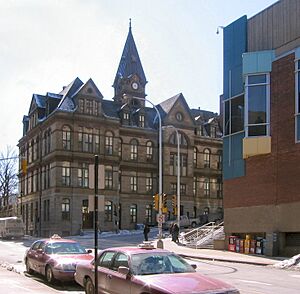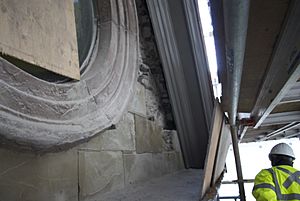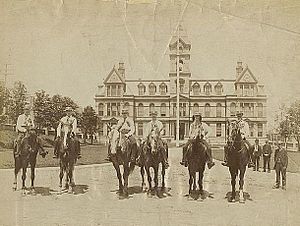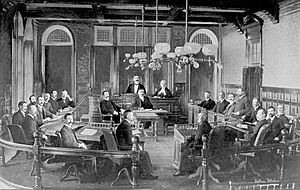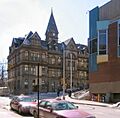Halifax City Hall facts for kids
Quick facts for kids Halifax City Hall |
|
|---|---|

Halifax City Hall, as seen from Grand Parade.
|
|
| General information | |
| Status | Complete |
| Architectural style | Late-Victorian Eclectic (Second Empire-influenced) |
| Location | 1841 Argyle Street Halifax, Nova Scotia B3J 3A5 |
| Coordinates | 44°38′55″N 63°34′31″W / 44.64861°N 63.57528°W |
| Construction started | 1887 |
| Opened | May 22, 1890 |
| Owner | Halifax Regional Municipality |
| Technical details | |
| Floor count | 4 |
| Lifts/elevators | 1 |
| Design and construction | |
| Architect | Edward Elliot |
| Main contractor | Rhodes, Curry & Co. |
| Official name: Halifax City Hall National Historic Site of Canada | |
| Designated: | 1984/11/23 |
| Type: | Municipally Registered Property |
| Designated: | 1981/10/06 |
| Reference #: | 23MNS0448 |
Halifax City Hall is where the local government of Halifax, Nova Scotia, Canada, makes decisions. It was designed by architect Edward Elliot and built between 1887 and 1890. It is one of the oldest and largest public buildings in Nova Scotia. This important building became a National Historic Site of Canada in 1997.
Halifax City Hall opened in 1890. It replaced older offices on the Halifax waterfront. In 1996, it became the main building for the new Halifax Regional Municipality. Today, it is home to the Halifax Regional Council and many city offices.
Contents
History of Halifax City Hall
Halifax City Hall is located at the north end of Grand Parade. This historic military parade square dates back to 1749. The building faces Duke Street.
Before City Hall was built, Dalhousie University stood on this spot. For many years, the city council wanted this land for public use. A deal was made by Premier Sir William Young. The provincial government helped the university move. The City of Halifax gave the university new land. The old university building was taken down. Some wood from it was even used in the new City Hall.
Building Design and Features
Edward Elliot designed Halifax City Hall. It was built for the City of Halifax from 1887 to 1890. It is one of Nova Scotia's oldest and biggest public buildings. It is also a National Historic Site of Canada. In 1981, it was listed as a Municipally Registered Property. This means it is protected under Nova Scotia's Heritage Property Act.
The building has a grand, mixed architectural style. It is made of cream and red sandstone. The ground floor and tower also use granite. The tower has seven stories. It has clocks on its north and south sides. The clock on the north side is stopped at 9:04. This remembers the terrible Halifax Explosion of 1917.
Life in the Early Years: 1890 to 1900
City Hall had five main entrances in 1890. The grand entrance from Grand Parade was for the public. It led visitors to the second floor. There were also entrances from Argyle Street. Three doors on Duke Street led to the police station. The police station was on the first floor until the late 1940s.
The first floor held the police court and jail cells. It also had rooms for police officers. Famous escape artist Harry Houdini escaped from these jail cells in 1896. This was only six years after City Hall opened!
The main floor (second floor) had many important offices. These included the Mayor's office and the City Clerk's office. The third floor was home to the Council Chamber. It also had the Citizens Free Library. Other offices like the Inspector of Licenses were there too.
The fourth floor had an apartment for the caretaker. It also had a large space. This space was called a ballroom, a gallery, or a museum. It might not have been fully finished when the building opened.
Changes Over Time: 1900 to 1996
After the Halifax Explosion in 1917, City Hall was badly damaged. Many important people met in the City Collector's Office. It was the only room still usable. They held emergency meetings there for several months.
On May 25, 1918, there was some unrest in downtown Halifax. This happened after a sailor was arrested. City Hall was affected. Some cars were overturned. A police wagon and motorcycle were thrown into the harbour.
The Citizens' Free Library was moved to City Hall in 1890. It stayed there until 1949. Then, it moved to the new Halifax Memorial Library. The library's collection later moved to the Halifax Central Library in 2014. The space where the library used to be is now used by the Mayor's office.
The Halifax Police Department moved out of City Hall in 1953. Their old quarters were too small. They moved to Brunswick Street. Later, in the 1970s, they moved to their current location.
In the 1980s, a group of citizens helped plan a big renovation. A large public meeting room called Halifax Hall was created. It used to be several offices. In the 1990s, a coating was put on the sandstone. This coating caused damage. Repairs were finished successfully in 2013.
Halifax Regional Municipality: 1996 to Present
In 1996, City Hall became the main building for the new Halifax Regional Municipality. It houses the Halifax Regional Council and many city offices. In the late 1990s, there was a plan to rename it Halifax Regional Hall. This was because Nova Scotia no longer has "cities." But people who cared about history protested. So, the name stayed Halifax City Hall.
A big, multi-year restoration of the building started in 2011. The original cornerstone and other stone parts were carefully fixed. About 80% of the outside stone was replaced with new sandstone. The roof was replaced. Heating and cooling systems were updated. The old elevator shaft was replaced with a new, full-size elevator. Inside, public and office spaces were improved. This was done while keeping the building's historic look.
Current Use of the Building
The Council Chambers were updated in 2012. This renovation helped make space for the smaller Regional Council. The council now has 16 members instead of 23. New wiring, communication, and video systems were installed. The room was set up in a horseshoe shape. This is like the original layout from 1890.
Halifax City Hall still has many important offices. These include the Chief Administrative Officer and the Municipal Clerk. The offices for the Mayor and Councillors are also here. The Mayor's office is on the third floor. The Councillors' offices are on the fourth floor.
Other city departments are in nearby office buildings. Some are in the Duke Tower. Others are in Alderney Gate in Dartmouth.
Images for kids


